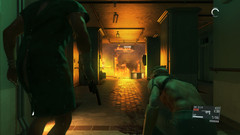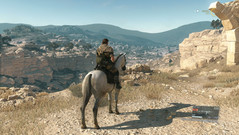Metal Gear Solid V Notebook Benchmarks
For the original German article, see here.
Graphics
Those who aren't familiar with the Metal Gear series are going to be stumped at first, as it is extremely difficult to make sense of the characters, the background story and the universe without knowing the previous installment. Despite that - or maybe just because of it - The Phantom Pain captures the imagination right from the start. Although the intro is a bit slow-moving in our opinion, the tension builds up nicely in similar fashion to highly choreographed ego shooters like Call of Duty.
The developers were particularly successful with how they staged the game. Thanks to continuously changing perspectives and thrilling camera movement, Metal Gear Solid V reminds us of a Hollywood production in some ways. That doesn't mean that this is a casual game, however - from a player's point of view, The Phantom Pain is comparable to stealth adventures like Splinter Cell, Thief or Dishonored. Controlling the game using the mouse and the keyboard is - for the most part - a very decent experience (exceptions: the menus don't support mouse control and there are controller overlays in the tutorial).
From a technical standpoint, the game impresses as well, although there are some areas where the title doesn't quite compare to other games released in 2015 like The Witcher 3 or GTA V, among others. In addition to very sharp textures, there are also object surfaces which are much less defined - quite a contrast compared to the carefully designed and credibly animated characters. Another negative aspect is the lack of higher-end anti-aliasing. FXAA, which is activated at higher post-processing levels, doesn't smooth the edges nearly as well as MSAA, for example. For that reason, many of the objects flicker (hair, bushes,...).
Aside from these flaws, we can't really criticize the Fox Engine, which is also used for Pro Evolution Soccer 2014-2016, among others. A plus point is the very good scalability, which helps out less powerful notebooks. We really liked the effects as well: in some action-heavy scenes, gamers get to experience a true explosion of dust, smoke and other particles. Lights and shadows are executed on a very high level as well. The cutscenes are compelling as well and round out the nice experience.
To run Metal Gear Solid V, DirectX 11 is required. The rest of the requirements are, as our benchmarks show, quite modest. The title remains playable even with a dual-core CPU. The fact that The Phantom Pain is part of Nvidia's "the way it's meant to be played"-series isn't noticeable - at least not in the graphics menu (no TXAA or similar). All settings are available for AMD GPUs as well, although the performance isn't quite up to par. With ForceWare 355.82, Nvidia already offers an optimized driver.
Something to consider: the retail DVD-package does not contain the actual game, but just the Steam Installer, which in turn means that a download of more than 20 GB is required. The start of the game is accompanied by a lot of messages and The Phantom Pain also needs to connect to a server, which many users won't appreciate much - especially considering that it does waste quite a bit of time.
Settings
The adjustment options are pretty extensive with the graphics menu offering 16 options, all of which don't require a restart. Some of the features can only be turned on or off, while others have a low, medium, high and extra high setting. The system is not uniform in that some settings are missing (it's impossible to play Metal Gear Solid V. completely on medium settings, for example).
Much more annoying, in our opinion, is the 60 fps limitation, which forces displays with 120 or 144 Hz to a lower refresh rate. Even with the vertical synchronization disabled, The Phantom Pain remains restricted to 60 fps. There's an option to restrict the frame rate down further to 30 fps, which doesn't make much sense in our opinion. At least we didn't encounter any crashes or major bugs. The PC platform desperately needed a reasonably well-engineered game after the disastrous launch of Batman: Arkham Knight.
The differences in performance of some of the systems had us scratching our heads. During the first run, the GeForce GTX 950 posted 42 fps with maxed-out details. After a short interlude with the settings on high, we recorded 57 fps with identical settings as before. Even a restart of the game didn't change the result. When we encountered fluctuations like that, we used the average of the two values. We suspect that the settings are not applied correctly at times.
Benchmark
The prologue in the hospital is not suited all that well for benchmarking, since there are too many cutscenes and the level-architecture is limited as well. That's why we use the first chapter entitled "Phantom Limbs", which takes place in a desert (Afghanistan). Because of the constant base frame rate - easily recognizable because of the low fps count - even a short sequence is sufficient. As the video below shows, we ride - after the intro - along a path for about 30 seconds until the horse approaches a crossing. Our colleagues from PC Games Hardware use the same exact sequence.
Results
Unlike a lot of current titles, Metal Gear Solid V doesn't need top-level hardware. Those who are happy with minimum details and a resolution of 1024 x 768 can successfully play The Phantom Pain with an HD Graphics 4600 or the HD Graphics 5500 (result for both above 30 fps).
For medium settings and 1366 x 768 pixels, a lower-middle class GeForce GT 740M is sufficient. More powerful midrange CPUS can sometimes handle high details and 1920 x 1080 pixels. An example is the GeForce GTX 850M which we clocked at 40 fps. Even the maximum settings don't have really high requirements as far as the hardware is concerned. From a GeForce GTX 960M on up, all settings can be maxed out. Metal Gear Solid V starts to get really demanding at 4K resolution, however. Only Nvidia'ss top-of-the-line GPU, the GeForce GTX 980M, can handle the settings on high and a resolution of 3840 x 2160 pixels without stutters.
All things considered, The Phantom Pain leaves us with a positive to very decent impression. The unique style and the atmosphere make up for the few weaknesses.
Note: we'll add the results for AMD GPUs in a few days.
| Metal Gear Solid V | |
| 3840x2160 High / On 1920x1080 Extra High / On 1920x1080 High / On 1366x768 Medium / Off 1024x768 Low / Off | |
| NVIDIA GeForce GTX 980, 3770K | |
| AMD Radeon R9 290X, 4790K | |
| NVIDIA GeForce GTX 980M, 4700MQ | |
| NVIDIA GeForce GTX 970M, 4700MQ | |
| NVIDIA GeForce GTX 880M, 4700MQ | |
| NVIDIA GeForce GTX 950, 3770K | |
| NVIDIA GeForce GTX 870M, 4700MQ | |
| NVIDIA GeForce GTX 960M, 4720HQ | |
| NVIDIA GeForce GTX 860M, 4700MQ | |
| NVIDIA GeForce GTX 850M, 4340M | |
| NVIDIA GeForce GT 750M, 4702MQ | |
| AMD Radeon R7 512 Cores (Kaveri Desktop), A10-7850K | |
| Intel Iris Pro Graphics 5200, 4750HQ | |
| NVIDIA GeForce GT 640M, 2637M | |
| NVIDIA GeForce GT 740M, 4200M | |
| NVIDIA GeForce GT 720M, 4200M | |
| AMD Radeon HD 8650G, A10-5750M | |
| NVIDIA GeForce GT 630M, 3720QM | |
| Intel Iris Graphics 5100, 4258U | |
| Intel HD Graphics 4600, 4700MQ | |
| Intel HD Graphics 5500, 5010U | |
Test systems
Four of our test systems are from Schenker Technologies (mysn.de):
- W504 (Core i7-4700MQ, 8 GB DDR3, GeForce GTX 860M, GTX 870M, GTX 880M, GTX 970M, GTX 980M)
- A505 (Core i7-4720HQ, 8 GB DDR3, GeForce GTX 960M)
- M504 (Core i5-4340M, 8 GB DDR3, GeForce GTX 850M)
- M503 (Core i7-4702MQ, 8 GB DDR3, GeForce GT 750M)
Three notebooks are courtesy of Nvidia:
- HP Envy 15-j011sg (Core i5-4200M, 12 GB DDR3, GeForce GT 740M)
- MSI CX61-i572M281BW7 (Core i5-4200M, 8 GB DDR3, GeForce GT 720M)
- Acer Aspire Timeline Ultra M3-581TG (Core i7-2637M, 4GB DDR3, Geforce GT 640M)
Intel also sent us a notebook:
- Schenker S413 (Core i7-4750HQ, 8 GB DDR3, Iris Pro Graphics 5200)
The desktop PCs have CPUs/APUs from Intel and AMD, SSDs from Micron, Intel and Samsung, Mainboards from Intel and Asus, as well as graphic cards from Nvidia, PNY and AMD. Our 4K monitor is an Asus PB287Q.
GPU drivers we used: Nvidia 355.82, AMD 15.8 Beta, Intel 10.18.14.4264 (Win 7) and 10.18.15.4256 (Win 10)


































